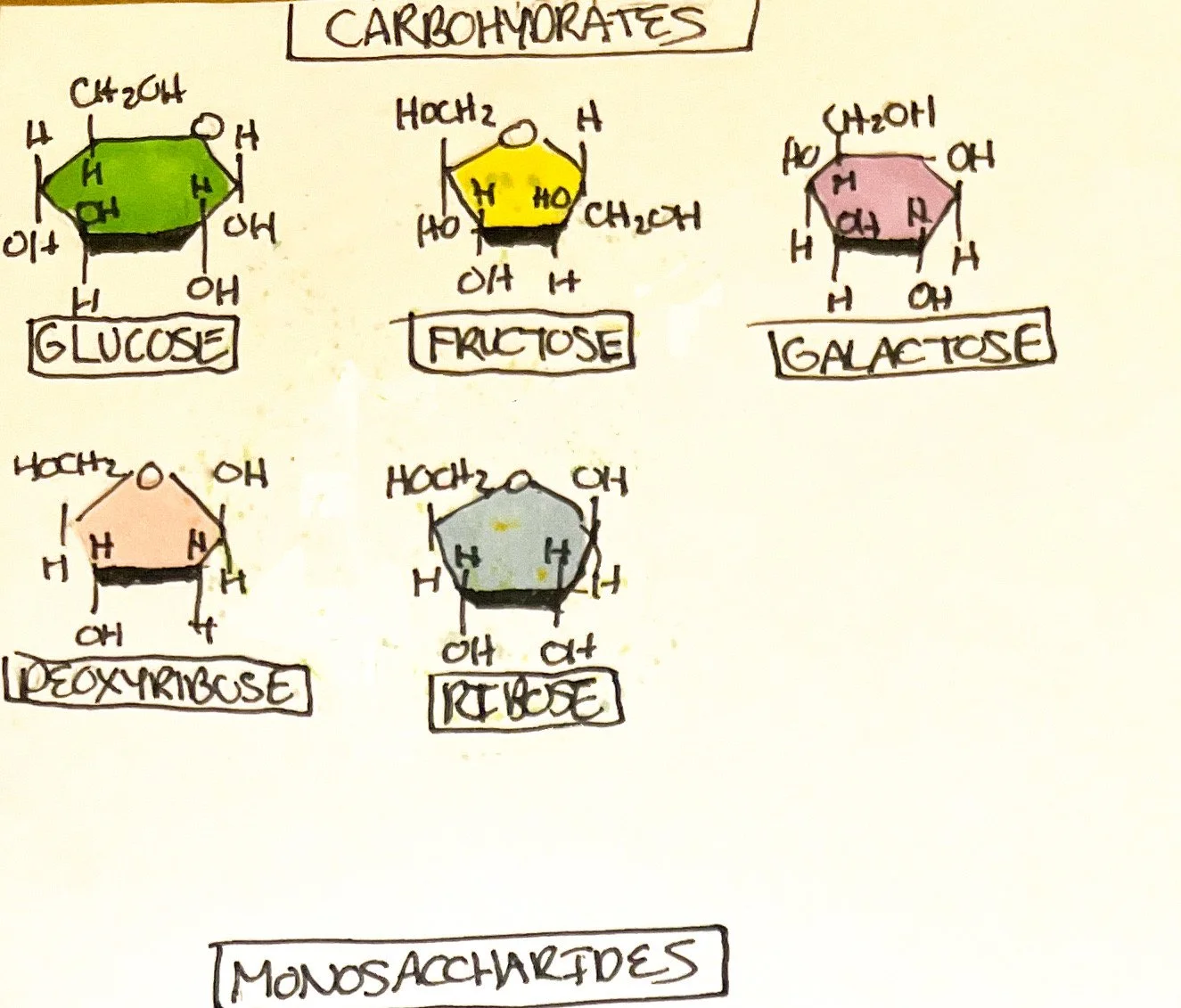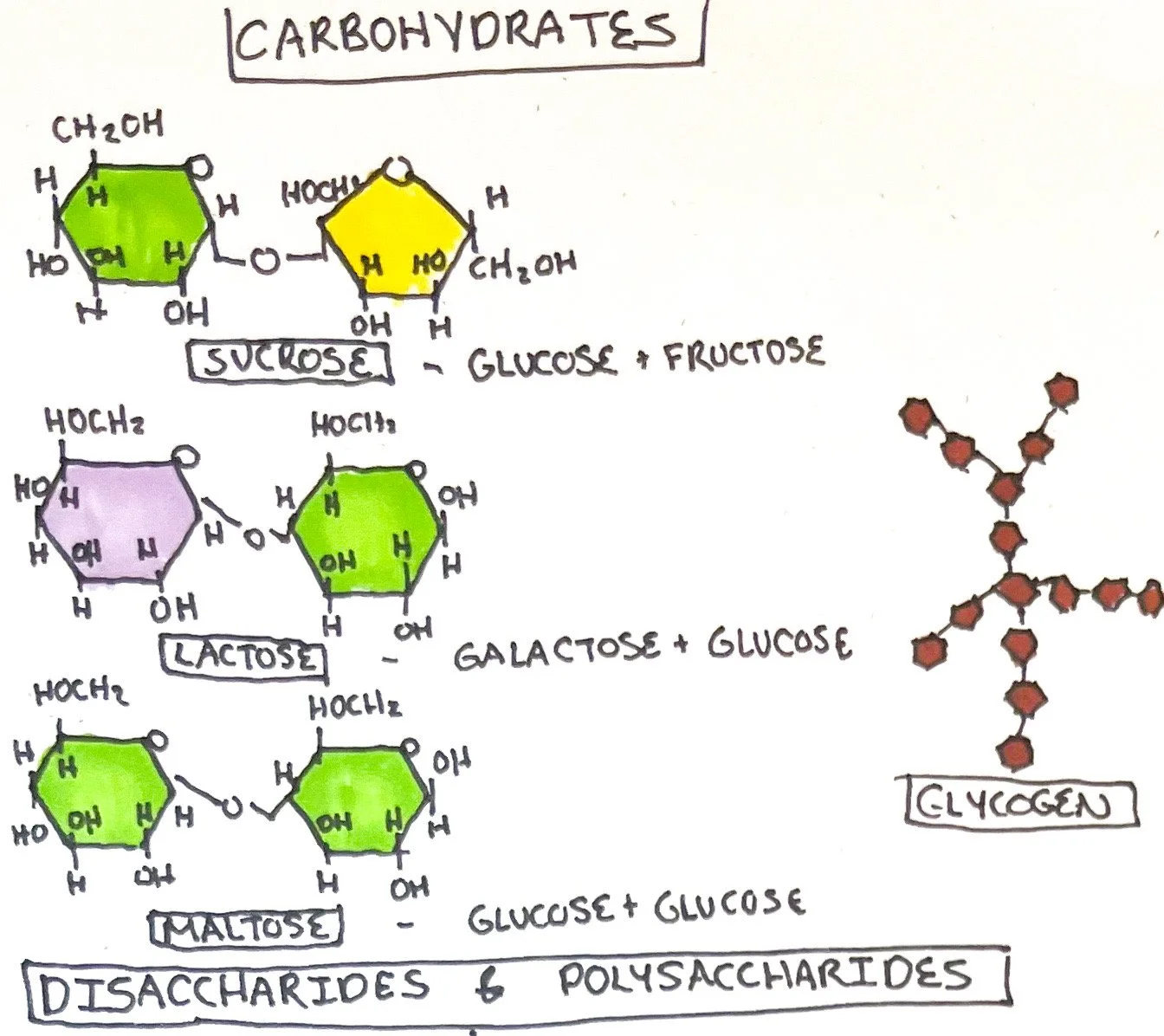Carbohydrates & Fiber
You should be able to:
Identify the different categories of carbohydrates and their chemical compositions.
Learn the recommendations for carbohydrates and how they can be tailored based on energy intake.
Understand where carbohydrates are primarily found in foods.
Explore the different categories, types, and functions of fibers.
Carbohydrates
Purpose: The purpose of this guide is to provide both chemical and nutritional information about carbohydrates.
What are carbohydrates?
When you think of carbohydrates, also referred to as carbs, you may think about rice, bread, potatoes, and pasta. This is true - all these foods are high in carbs. But what actually are carbs?
Carbohydrates are made up of carbon, hydrogen, and oxygen atoms. Two or more of these atoms are paired together to form molecules. Molecules that include carbon in their structure are known as organic compounds.
Carbs are one of the three macronutrients (the other two being lipids and protein). Since the body cannot produce it in adequate amounts in order to sustain life without receiving it from the diet, carbohydrates are also considered an essential nutrient.
Overall, carbs are organic compounds consisting of carbon, hydrogen, and oxygen molecules in different arrangements that have a variety of forms and functions, including starches, sugars, glycogen, and cellulose.¹
What are the types of carbs?
Carbohydrates can be divided into categories. The three primary groups of carbs include monosaccharides, disaccharides, and polysaccharides.¹
Monosaccharides
Monosaccharides are monomers, or building blocks, of carbohydrates. Monosaccharides are considered a simple sugar and consist of 3-7 carbons. When grouping carbohydrates, the suffix -ose indicates that it is a monosaccharide, and the prefix tells the amount of carbons found in the monosaccharide. The following is a list of monosaccharides¹ ² :
Trioses: 3 carbons
Glyceraldehyde, dihydroxyacetone
Tetroses: 4 carbons
Erythrose, threose, erythrulose
Pentoses: 5 carbons
Ribose, arabinose, xylose, ribulose, xylulose
Hexoses
Glucose, mannose, galactose, fructose, sorbose, tagatose
Common Monosaccharides
Glucose/Dextrose: referred to as ‘blood sugar’. Found in some ripening fruits and vegetables, but hydrolysis of disaccharides and starch is the primary method of glucose within the diet.
Fructose: sugar found in fruit, found in honey and fruit naturally.² Derived from the disaccharide sucrose.
Galactose: sugar found in milk, not often found in foods. Most galactose in the diet is derived from the disaccharide lactose.
Deoxyribose: part of DNA
Ribose: part of nucleic acids RNA and DNA. Also within the structures of other nucleotides and adenosine triphosphate (ATP), used for energy within the cell.²
Disaccharides
When two monosaccharides link through dehydration synthesis reactions (water is removed during this reaction), a disaccharide is formed. Disaccharides are linked by acetal bonds (a.k.a. glycosidic bonds since they occur in carbs).¹ A disaccharide can be broken down into a monosaccharide through hydrolysis reactions (water is formed during this reaction). The following are types of disaccharides:
Sucrose: Glucose +Fructose, also known as table sugar found in several sources in the diet. ¹
Lactose: Glucose + Galactose, which is the sugar found in milk. ¹
Maltose: Glucose + Glucose, which is malt sugar. It is not significantly found in the diet alone but is a product of polysaccharide digestion.¹
Polysaccharides
When multiple monosaccharides (ranging from ten to hundreds) link together, they form polysaccharides. The alpha and beta positions of the linkages are designed to work with specific enzymes within the digestive system.¹ Polysaccharides are more complex chains and are referred to as complex carbs. The following are known polysaccharides:¹
Oligosaccharides: Polysaccharides that are made up of 3-10 monosaccharides. It includes stachyose, verbascose, and raffinose which ferments in the colon, producing gas.²
Glycogen: A branched-chain polymer that serves as a form of stored carbohydrates in animals.² In humans, glycogen is stored in the liver and muscle cells.
Starches: A form of stored carbohydrates in plants and a major carb source in the diet.
Starch comes in the form of amylose (straight-chain glucose polymer) and amylopectin (branched glucose polymer).² When broken down into smaller components, glucose is formed.²
Cellulose: Cell walls of plants that are indigestible for humans. It is considered a type of fiber that helps with gut motility and adds bulk to stool.²
What is the function of carbs in the body?
The main function of carbohydrates in the body is to provide energy, known as adenosine triphosphate, or ATP, when metabolized. Carbohydrates are limited in being a structural component of the body but are part of DNA and RNA in the form of monosaccharides deoxyribose and ribose.¹ Carbohydrates also aid in composing the glycocalyx which aids in cell recognition, bacteria resistance, and vascular functions.¹ Another example of a non-energy source of carbohydrates is the polysaccharide glycosaminoglycan which plays a role in body secretions and lubrication around joints and connective tissues.²
What is the recommended amount of carbs?
The AMDR is reflective of dietary patterns of nutrients while the RDA focus is on meeting the requirement for daily functioning. The Acceptable Macronutrient Distribution Range (AMDR) of carbohydrates for individuals between 1-18+ is defined as 45-65% of daily calories.³ The AMDR is intended to set a caloric range for macronutrients that promote sufficient amounts of essential nutrients and lower chronic disease risk.³
The Recommended Dietary Allowances (RDA) for carbohydrates are 130 grams for children and adults between 1-70+ years old.³ The RDA is the sufficient amount of nutrients for 97-98% of healthy individuals. Carbohydrates provide 4 calories per gram whether simple or complex, and there are 15 grams of carbs in one serving. ³
Example: Determining Kcals, Grams, and Servings of Carbs When Daily Calorie Requirement is Known.
To determine the amount of calories from carbs, multiply your daily calorie requirement by the AMDR. This provides the amount of calories from carbohydrates.
Example: 2000 kcals/day
2000 kcals/d x 45% = 900 kcals from carbohydrates
In order to determine grams of carbs, divide kcals from carbohydrates by 4 (4 kcals per gram)
2. 900 kcals from carbs / 4 = 225 grams of carbs.
Furthermore, to determine the amount of servings of carbs per day, divide grams of carbs by 15 (15 g carbs in one serving)
3. 225 grams of carbs/15 = 15 servings of carbs per day.
What foods contain carbs?
Plant foods, fruits and vegetables, compose the most abundant amount of carbs in the diet. Animal milk also contains carbohydrates, but other animal products are not a significant source of them.
Dietary Fiber
What is dietary fiber?
Dietary fiber is considered to be a type of non-digestible carbohydrate and plays several important roles within the body. Lignin, a non-carb polymer, is also considered to be fiber.²
What are the different forms of fiber?
Fiber is categorized as insoluble or soluble. Insoluble and soluble refers to if the fiber can dissolve in water. Insoluble fiber does not dissolve in water while soluble fiber does. Insoluble fibers include cellulose, hemicellulose, modified cellulose, and lignin.² Soluble fiber includes gums, pectin, and mucilages.² There are several other types of fiber and subcategories of them. Below is a detailed look at some common fibers listed above:
Insoluble Fiber
Cellulose: a polysaccharide made of repeating glucose units used in plants’ cell walls. Used as an anticaking or thickening agent in food derived from cotton or wood.²
Hemicellulose: a polysaccharide composed of covalently bonded pentoses and hexoses both straight chain and branched used for plants’ structure.²
Lignin: a polymer consisting of aromatic alcohols coumaryl, coniferyl, and sinapyl present in the cell wall of plants and notable for its ‘woody’ properties.²
Soluble Fiber
Gums: polysaccharides that can have uncharged or charged polymers.² It is derived from seaweed; types include carrageenan, sodium alginate, and agar. Other sources that are non-seaweed derived include gum arabic, guar gum, B-glucan, tara gum, etc. It is used for thickening, gelling, emulsifying, and stabilizing purposes.²
Pectins: polysaccharides with often methylated repeating galacturonic acid monomers that are found within the cell walls of plants.² It serves as a thickener, gel, and stabilizer in foods due to it being jelly-like.
B Glucans: polysaccharide composed of glucose in a straight or helical structure most commonly found in cereal grains like barley and oat.²
Fructans: polymers of fructose. Some examples are inulin, oligofructose, and fructo-oligosaccharides.² They are typically indigestible but some bacteria may be able to break bonds.
Polydextrose: polysaccharide that forms with the combination of glucose and sorbitol. They are used as a bulking agent in food manufacturing but also used as a sweetener.²
.Psyllium: husks of Plantago ovata seeds used for mucilage.²
Resistant Starches: starches that do not digest and are fermented in the colon.²
Oligosaccharides: galactosyl sucrose derivatives in the raffinose category of sugars are different from other oligosaccharides and ferments in the colon.²
What is the function of fiber?
Fiber is usually a component of structural integrity for a plant. In humans, insoluble and soluble fibers play different roles within the body. Insoluble fiber passes undigested through the GI tract but aids digestion by quickening the passage of food within the gut.⁴ Insoluble fiber also adds bulk to feces.
Soluble fiber creates a gel substance since it dissolves in water, slows down digestion, lowers the glycemic effect of carbs, and stabilizes blood sugars. It also lowers LDL (low-density lipoprotein) cholesterol.⁴ The fermentation of soluble fiber produces short-chain fatty acids responsible for GI cell energy and healthy gut bacteria. They are believed to play a role in fighting diseases such as cancer.
What is the recommended amount of fiber?
The current recommendation for fiber is set as Adequate Intake (AI). AI is similar to RDAs but has less scientific information to define it as such.³ The following are recommendations³:
What are food sources of fiber?
Whole grains, legumes, fruits, and vegetables are food sources of fiber. Specifically, insoluble fiber is found in vegetables and whole grains, and soluble fiber is found in legumes, oats, barley, and some fruits and vegetables.³
Source(s):
1. Jerry Tortora and Bryan Dickerson, Principles of Anatomy & Physiology, 16th ed. (New Jersey: John Wiley & Sons, 2021).
2. Denise M Medeiros and Robert E.C. Wildman, Advanced Human Nutrition, 4th ed. (Burlington, MA: Jones & Bartlett, 2019).
3. https://ods.od.nih.gov/HealthInformation/nutrientrecommendations.aspx#dri
4. https://medlineplus.gov/ency/article/002470.htm


